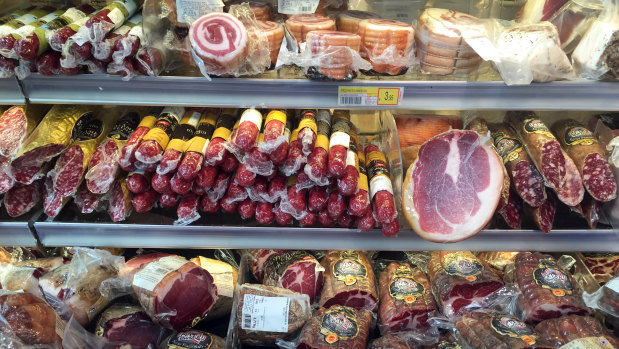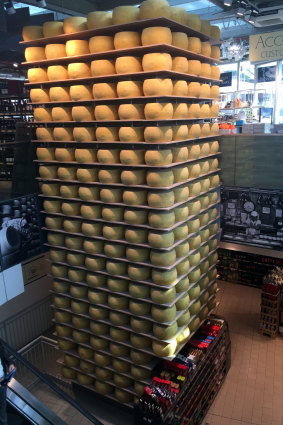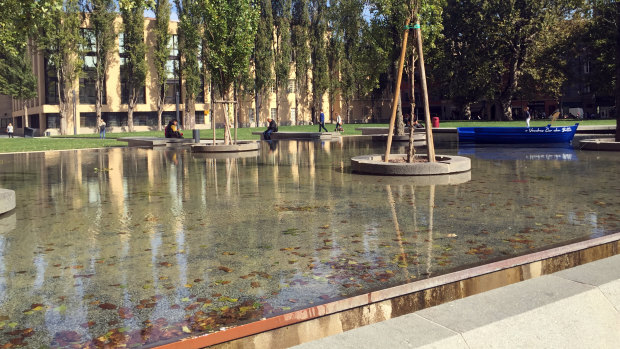By Lia Timson
Parma: Ah, Italy! So much food, so little time.
It started as just a quick stop on a long day’s driving from west to east across the top of “the boot”, but our stomachs began pleading with us after passing so many road signs with food names.
Carbonara al Ticino. Gorgonzola. Reggio Emilia. Modena. Bologna. The headquarters of pasta and pesto maker Barilla.

A cold meats display in Parma, Italy.Credit: Lia Timson
By the time we see the turn-off to Parma, the decision is made: it’s lunch time.
European towns have a wonderful habit of springing markets on you and Parma is no different.

A tower of parmesan takes centre stage at a deli in Parma.Credit: Lia Timson
Hidden behind old building facades facing away from an unremarkable river, lie a number of small streets and quaint village squares filled with colour, movement and history.
Being a Saturday, the historic centre is bubbling away with visitors and the central market near the 16th-century Palazzo della Pilotta is teeming with residents and students chasing a bargain (here they sell cut-price imports from Eastern Europe, rather than Bali or Bangladesh).
Then out of the corner of my eye rises a three-storey-high installation of soft-yellow wheels behind a deli's shop window. What is that?
Then it hits me: this is the home of Parmesan cheese. And there it is, enough of the real thing to fill a supermarket warehouse in a monumental display of pride, right in the middle of a deli full of that other delicacy di Parma: prosciutto.
I've read somewhere that you should never do the grocery shopping while hungry and this proved the point. Soon enough, our basket is overfilled with cheese, prosciutto, bread, olives and arancini.
I try my Italian, or what I think is Italian, to order a similar amount of salami to the prosciutto I just purchased from the charming deli server: "Lo mismo de salami, per favore", I risk.
"That's Spanish," he says with an unmistakable wink. "We say ugualmente for 'the same'." (Right. Remind me to speak Portuguese next time - it's closer.)

Genuine and in abundance does not mean cheap, but Parma produce deserves a lunch stop.Credit: Lia Timson
One of the region’s main brands describes the prosciutto di Parma DOP as “one of the jewels in the crown of Italian cold meats. Made of only the thigh of Italian pigs and salt, with no preservatives, following a tradition that has been handed down for more than 1000 years”.
DOP stands for Denominazione di Origine Protetta (or protected designation of origin) and is a very strict certification that ensures certain foods are grown, processed and packaged at their source. Authorities offer it as a guarantee the goods were produced by local farmers and artisans using traditional methods. The less stringent IGP (protected geographic origin) guarantees at least one phase of production is done at the source.
According to the Walks of Italy blog, the labels can only be applied to certain foods from certain areas, including balsamic vinegar from Modena and Reggio Emilia; olive oil from 11 regions including Tuscany; Parmigiano Reggiano cheese from Lombardia and from Emilia Romagna (where Parma is located); and basil from Liguria whose capital is Genova and famous sauce is the pesto Genovese.
In the end, the DOP label, the undisputed quality of our purchases and the Aussie dollar exchange rate guarantee a grocery shopping expense that is on par with lunch for four people in a cafe.
But it was a genuine Parma snack and, enjoyed in a tucked-away square within the palazzo complex, it made for a fabulous stop.
Forget a cheap Parma night. The expensive picnic won the day.

A reflection pool among Parma buildings proves a refreshing place for a picnic.Credit: Lia Timson
Get a note directly from our foreign correspondents on what’s making headlines around the world. Sign up for the weekly What in the World newsletter here.